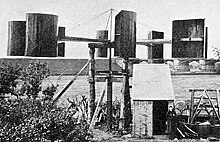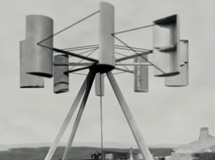James Blyth (engineer)
James Blyth (born April 4, 1838 in Marykirk , Kincardineshire , † May 15, 1906 in Glasgow ) was a Scottish electrical engineer and scientist at Anderson's College, now the University of Strathclyde in Glasgow. He was a pioneer in the field of electricity generation from wind energy . The wind turbine he built , which he used to light his holiday home in Maryhill , is considered to be the first system that could use wind power to generate electricity. Blyth patented his design and later developed an improved model that served as an emergency power supply at the Sunnyside Royal Hospital (formerly Montrose Lunatic Asylum, Infirmary & Dispensary) for the next 30 years . Although Blyth was recognized for his scientific merits, generating electricity from wind power was deemed uneconomical. No other wind turbines were built in the UK until 1951 .
The early years
James Blyth was on April 4, 1839 in Marykirk , County Kincardineshire born. He attended the local parish school there and later the Montrose Academy before receiving a scholarship to the General Assembly Normal School in Edinburgh in 1886. After Blyth graduated from the University of Edinburgh as a Bachelor of Arts, he taught mathematics at Morrison's Academy in Crieff in 1861 and helped set up school classes at the newly formed George Watson's College in Edinburgh.
Blyth completed his Master of Arts in 1871 and married Jesse Wilhelmena Taylor in the same year at the United Presbyterian Church in Athol Place, Edinburgh. They had two sons and five daughters, two of whom died in childhood.
Professional career
「" His students - gone forth from the classroom, and radiated over the country and to far corners of the world ... all bear in the secret structure of their minds the impress of Professor Blyth's teaching, and will cherish through life, with reverence and affection, the memory of their teacher and friend. "」
"His students who have left college and who have gone all over the country to the deepest corners of the earth ... still have in the hidden structures of their minds the impression that Professor Blyth's teaching left there and they will be Remembering your teacher and friend with awe and affection throughout your life. "
In 1880 Blyth received the "Freeland Endowed Professorship" in natural philosophy at Anderson's College in Glasgow, which in 1886 became the Glasgow and West of Scotland Technical College . While teaching at this college, he pursued a research program that looked at the generation and storage of electricity. Blyths was considered a hard-working scientist and was popular among his students and colleagues and known through a number of lectures in the community.
In July 1887, Blyth built a canvas-covered wind turbine in the garden of his holiday cottage in Marykirk and charged batteries with the electricity it produced . He used the stored energy to supply his living space with light. It was the first house in the world that was powered by electricity generated by wind power.
In a paper for the Philosophical Society of Glasgow on May 2, 1888, Blyth describes the wind turbine “as a three-legged construction with a 10-meter-high shaft, four 4-meter-long blades covered with canvas and a Bürgin dynamo, which is powered by the flywheel is driven by a rope ". In moderate winds, the turbine generated enough electricity to supply ten 25 V light bulbs and could even be used to drive a small lathe.
In the following years he experimented with a number of different designs. The final design was in operation for 25 years, generating more electricity than needed. Blyth then offered this to the residents of Marykirk for lighting the main street. However, his offer was rejected because electricity was believed to be the "work of the devil". In November 1891, Blyth was granted a UK patent for his wind machine . In 1895 he granted the Glasgow mechanical engineering company Mavor and Coulson a license to build a second, improved turbine, which served as an emergency power supply for the Montrose Psychiatric Clinic and was successfully operated there for the next 30 years.
Blyth's original wind turbine was the first documented device to generate electricity using wind power. However, the lack of a braking mechanism made them vulnerable to damage that can occur in strong winds. In the winter of 1887, a few months after Blyth's first wind turbine was built, the American Charles Francis Brush built the first automatically operated wind turbine. Due to its design, it could be switched off by hand to protect it from wind damage. The improved version of the turbine for the Montrose Mental Hospital (based on John Thomas Romney Robinson's anemometer design) reduced the susceptibility to such damage, but it could happen that the locking mechanism did not work in very strong winds.
In 1891 Blyth presented the Royal Society of Edinburgh , of which he had been a member since 1878, a work in which he advocated his belief in the benefits of renewable energy sources such as wave , but especially wind energy. Later that year he was awarded the Brisbane Gold Medal by the Royal Scottish Society of Arts for his work on generating electricity from wind energy. However, his wind turbine was not considered economically feasible.
Blyth's other interests included the relative effectiveness of different forms of lightning, telephone connections, and microphones. He also contributed a number of subjects to the Encyclopædia Britannica .
The late years
The University of Glasgow awarded Blyth an honorary doctorate in 1900 . He died of a stroke on March 15, 1906 at his home in Glasgow . His friend Dr. James Colville remembered him as "a true man of science ... one who, through understanding, patient, hard work, and mechanical ingenuity, has accomplished much in his life and exemplified many things in science."
The turbine at the Montrose Mental Hospital was dismantled in 1914. Britain's first public wind turbine was put into service until 1951, when the company John Brown Engineering from Glasgow a prototype at Costa Head ( Orkney built).
See also
Individual evidence
- ↑ a b c d e f g Chris Hardy: Renewable energy and role of Marykirk's James Blyth . In: The Courier . DC Thomson & Co. Ltd .. July 6, 2010. Archived from the original on March 14, 2012. Info: The archive link has been inserted automatically and has not yet been checked. Please check the original and archive link according to the instructions and then remove this notice. Retrieved December 12, 2010.
- ↑ a b c d e f g h i j k l m n Trevor J. Price: Blyth, James (1839–1906). In: Henry Colin Gray Matthew, Brian Harrison (Eds.): Oxford Dictionary of National Biography , from the earliest times to the year 2000 (ODNB). Oxford University Press, Oxford 2004, ISBN 0-19-861411-X , ( oxforddnb.com ), as of October 2009, accessed October 9, 2009.
- ↑ a b c It als started here: No.9 Wind Power . In: Strathclyde people . Retrieved on May 19, 2011. ( Page no longer available , search in web archives ) Info: The link was automatically marked as defective. Please check the link according to the instructions and then remove this notice.
- ↑ Anon: James Blyth 1880-1906 . In: Former Professors of Natural Philosophy in the Glasgow and West of Scotland Technical College (founded in 1886) . University of Strathclyde. Archived from the original on July 17, 2012. Info: The archive link was automatically inserted and not yet checked. Please check the original and archive link according to the instructions and then remove this notice. Retrieved December 12, 2010.
- ↑ It all started here: No.9 Wind Power . In: Strathclyde people . Retrieved on May 19, 2011. ( Page no longer available , search in web archives ) Info: The link was automatically marked as defective. Please check the link according to the instructions and then remove this notice.
- ↑ Making Scotland's landscape: The Climate Presented by Professor Iain Stewart, Producer Michael Burke, Director Colin Murray, BBC Scotland Television screened December 11, 2010
- ^ Biographical Index: Former RSE Fellows 1783–2002. Royal Society of Edinburgh, accessed October 10, 2019 .
- ↑ Secretetary of State for Scotland: Secretary of State for Scotland: Scotland Office / Royal Society of Edinburgh Climate Change Seminar . Crown copyright. Archived from the original on March 8, 2012. Retrieved May 19, 2011.
| personal data | |
|---|---|
| SURNAME | Blyth, James |
| BRIEF DESCRIPTION | Scottish pioneer in the field of wind power generation |
| DATE OF BIRTH | April 4, 1838 |
| PLACE OF BIRTH | Marykirk , Kincardineshire |
| DATE OF DEATH | May 15, 1906 |
| Place of death | Glasgow , Renfrewshire |

